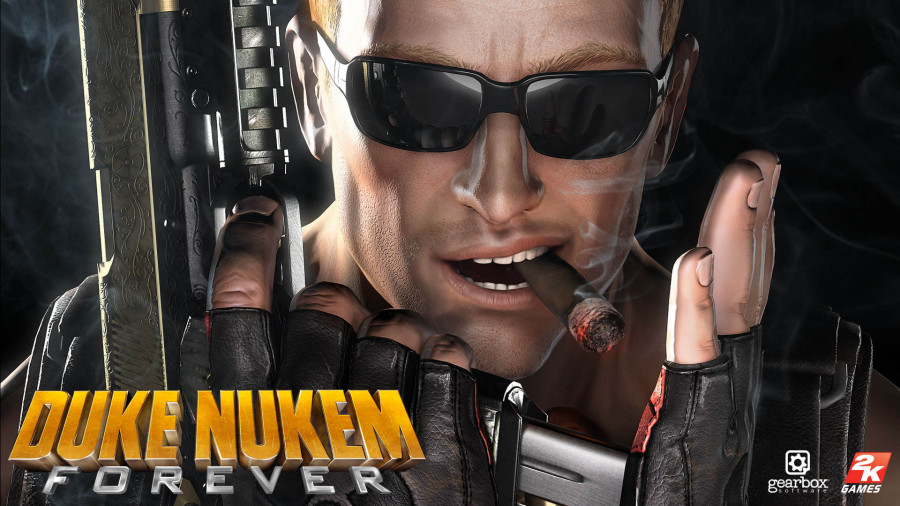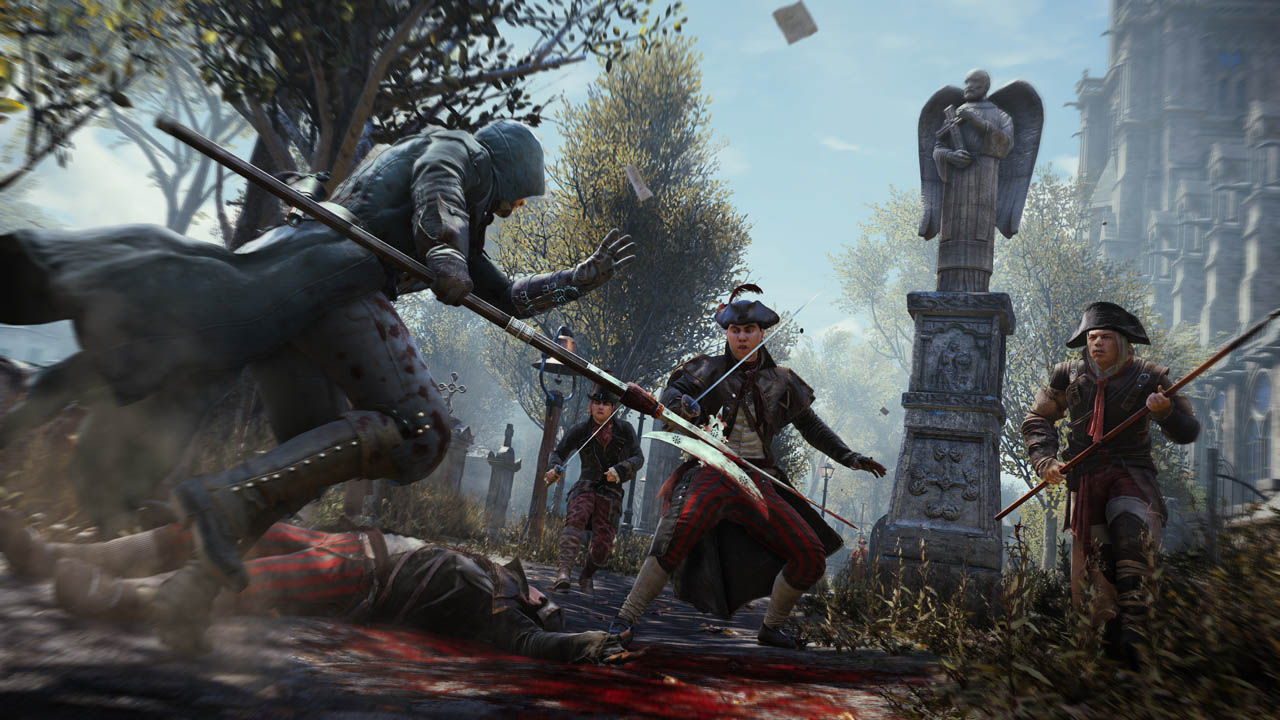

After an intensive period of playing as both the Germand and Soviets in the Company of Heroes 2 Open Beta I feel that for all those who never played a Company of Heroes game, yet are curious how it plays out, I decided to write up this Guide. Company of Heroes 2 differs from Company of Heroes 1 in a number of ways. The addition of the Winter is one major change. The Economy has been slightly reworked, and it is much harder to “Spam” effectively, but it is still possible. I will try to include as much information as possible, even though a lot of it may be found in the game’s Tutorial and Tips Videos (as well as Hints). However, I will include a few Tips of my own, and Strategies you may use against you enemies, be it when playing as the Soviets or Germans.
Take note, this is from my Open Beta experiences, what you might have in the actual game can differ from what I state here, so the Guide might, eventually, also change, as I dwell into the main game itself. Also, because I had problems running the game on anything higher than MINIMUM graphic setting the screenshots look… terrible…
Also, in case you are wondering, the lack of links to a Wiki is because there is none (yet). As soon as some solid content appears I will link it as well. If you are looking for more info we have a general list of Company of Heroes 2 Guides.

Why would you play a Wargame if not to fight other people?
Company of Heroes 2 is an RTS. You construct and upgrade your base, unlocking more units and upgrading your troops on the field. Your units can level, gaining more abilities and improving their stats. There are currently two sides to the conflict, the Germans and the Soviets. Each side has its own strengths and weaknesses, all of which I will try to mention in the Soviets and Germans Guide. (Not yet written, because I have to gosh darn sleep!)
I will not focus on the controls themselves, since that you can figure out on your own. Let’s start with the two Multiplayer Modes available.
There are two Multiplayer Games Modes available (aside from Theater of War that I did not have a chance to test). Both of these modes are similar to what we had in Company of Heroes 1. Annihilation and Victory Points. Annihilation is about the TOTAL destruction of the enemy. In order to win here you have to destroy every building the enemy team might had built. This is one of the longest game modes, so be prepared to have even two hours of free time, since a balanced game could well last that long. Victory Points can be much quicker, and in a “Total Win” situation the game could be over in anywhere between 15 to 20 minutes (unless the enemy surrenders).

A Victory Point. While it may be held by my team it is completely unprotected… not a good sign.
Victory Points is about taking Victory Locations. The team that holds the majority of the points begins subtracting points from the enemy “pool”. The team which has a depleted point pool looses. There are three Victory Locations on each map, so both in larger and smaller games you are forced to often split your forces to hold even two of these points.
Each Online Game and Campaign Mission will grant you experience. This experience will allow you to increase your Rank. Your Rank does not only represent your (theoretical) experience but it also allows you to unlock more Commanders, Skins and Bulletins.
Commanders are your Special Abilities and Call-Ins. When you setup a Preset for your games you can pick three Commanders. In other words, if you had ten different German Commanders you can bring only three of them to a battle, and then during a Battle you can only pick one of them, with all of his benefits. Each Ability and Call-In a Commander has calls for a certain number of Ability Points. Ability Points are gained through actions during a battle, such as building structures or killing enemies. Some Abilities have the same Ability Point Requirement, which means you need, for example, two Ability Points in order to use the two Abilities that both cost Two Ability Points Each. You do not use up Ability Points, they simply unlock your abilities.
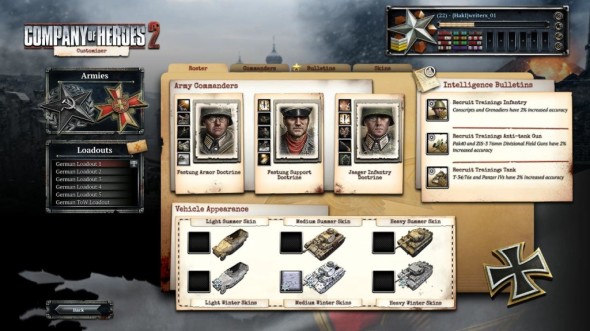
An example of an “Battle Setup”. You can see the three chosen commanders, bulletins and skins that I will have.
The more Commanders you have the wider your choice in strategies. You might be more defensive, more centered on Infantry or Armor, the decision is yours. It is a good idea to keep a decent variety of commanders, so that you can adapt to the choices your Allies and Enemies will make.
Skins make your Vehicles look nice. They come in the Summer and Winter variants, so depending on which map you will play on appropriate chosen skins will appear. They hold no special benefits, other than cool looks.
On top of this you also have Bulletins. You pick only three bulletins for your setup, and their task is to offer different bonuses to your specific units. Bulletins can benefit your different units in many ways. So, you might have a bulletin that allows your Panzer IVs to gain experience faster. Or one that allows for better weapon accuracy on your Stug III. In order to use a Bulletin you need a high enough Rank and then you have to complete a challenge (or set of challenges) associated with said Bulletin. This might be something simple, like building a certain structure or using a specific ability, a certain number of times. However, some Bulletins have very tough challenges, such as where Grenadiers have to kill 5 Heavy Tanks with Panzerfausts (good luck with that).
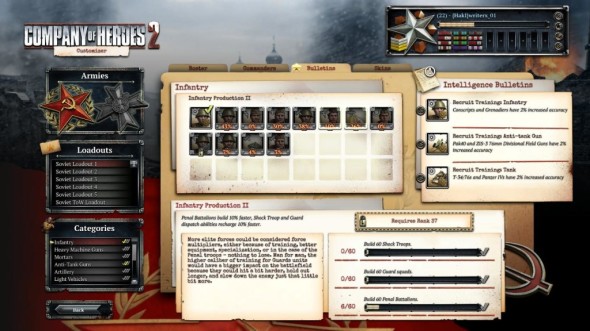
Bulletins offer different bonuses, but in order to get them you need to put a lot of effort and time.
The combination of Bulletins and Commanders allows you to create Combos that you think will benefit you the most, during the game. Experiment a bit and you might find something you like… and be patient. You will not get the bulletins you want on your first few games.
There are three types of Resources. Manpower, Ammunition and Fuel. Manpower is used for almost everything, such as Building, Recruitment and Upgrades. The only exception are some abilities, except for off-map call-ins (such as the T-34/85). Ammunition is typically used for two things, Upgrades and Abilities (both Commander and Unit abilities). I did not see it used on any unit recruitment (and none of the artillery units need Ammo to fire). Fuel is the blood of any army, for numerous reasons. On the most basic level it is needed to construct Base Structures. Without Base Structures you cannot unlock more unit types. In the case of the Germans Fuel is needed not only for Base Structures, but also HQ Upgrades needed for these new buildings. Vehicles are also something that needs fuel, and tanks need an awful lot of it. There is, normally, no such thing as too much fuel. Manpower can also suffer a short supply if you have too quickly expanded or rebuilt your force.
Unlike in Company of Heroes 1 your troops can “Cap” a point (including Victory Locations) simply by standing near them. Infantry can do this freely, or even “block” a capture, if units from opposite sides stand within the same point. Tanks cannot Capture points (unless they have an ability allowing this). Curiously enough, infantry inside a half-track can capture points, from inside the half-track.
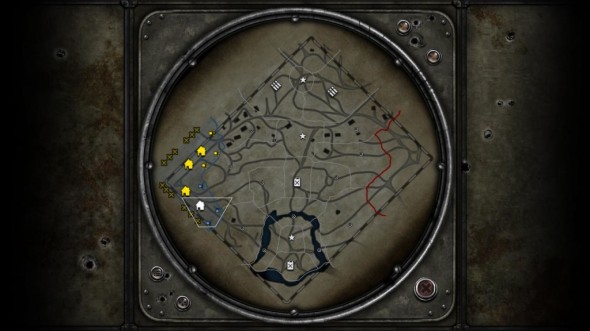
The Tactical Map allows you to get a good glimpse at where are the different resources. Circles are Manpower (here, not shown on the Tactical Map), Ammo is Ammo and Fuel Cans are Fuel. Manpower points can be upgraded to also produce Fuel and Ammo, through your Engineers/Pioneers.
The Germans use a “Linear “Progression in the Unlocking of their forces. They have four Stages of their force’s progression. During the first stage you can have basic infantry (Pioneers, Grenadiers, HMGs and Mortars). During the later stages you unlock more units, but it is not until the third and fourth stage that you actually gain access to tanks. The good news is that you do NOT have to build every structure that you unlock. Let us assume that you Upgraded your HQ fully. You do not need all the buildings in order to recruit a Panther, just the fourth and final one. In general I do not recommend skipping over “unit groups”, since you never know when you might need a seemingly weaker unit.
The Russians follow a “Two Tiered” Model. Initially you can build two “Infantry” buildings. Once you build any one of them you unlock the Tank and Support Tents, so you can, for example, Build a Specialist Rifles Tent, and then a Tank Tent. Unlike the Germans though, the Soviets have an easier time progressing to heavier units, even if recruiting them will still cost you an awful lot of fuel at an early game.
As such, you could say that the Russians are more flexible, since the Germans have to progress through all the possible stages to unlock their better vehicles and units, but that is not necessarily the case. Germans have access to very solid counters very early on in the game. Combined with your Commander’s Special Abilities the balance does not seem tipped in either side’s favor too much.
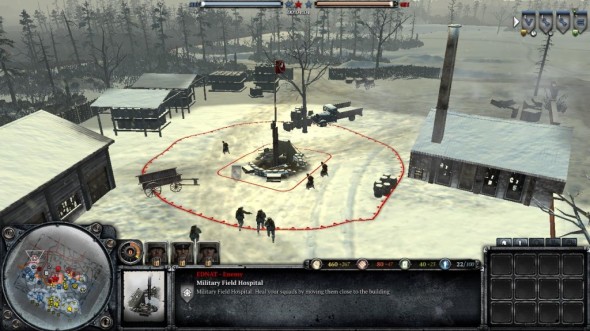
A Medical Point currently held by the enemy. You can see three Medics standing around the point. You do not have to kill the Medics to capture the point, just send a squad to stand on the point.
Recently I also encountered two new types of “Points” that may be captured, Watchtowers and Medical Points. Watchtowers, when captured, provide a wide field of vision of a portion of the battlefield around them. Medical Points when captured spawn a number of Medics allowing them to heal troops in the area who are out of combat. So far I found these on the City 17 Winter Map, and I found that having a Medical Point can really ease the pressure off your resources, be it on the attack or defense.
You can construct a number of simple battlefield structures, using your Pioneers, Combat Engineers, Conscripts or Grenadiers. The Germans have the Bunker, which is EXTREMELY versatile. It may be upgraded to use an HMG, you can turn it into Medical Bunker, healing all nearby units, or into a Command Outpost, allowing your Squads to Reinforce at the front (you cannot use it to call-in new units however). These bunkers are not nearly as solid as those in Company of Heroes 1. Far from it. Molotovs and flamethrowers will have a surprisingly easy time taking them out, as well as any infantry hiding within them. While the cost of building a bunker is relatively low its upgrade cost is high, so guard your bunkers! Do not build them in dangerous locations.
The Soviets, in turn, have Sandbag Walls. These act as “Green Cover” (the best type of cover) and due to their length and thickness you could use them to block off bridges or thin passages, in swamps. The Soviets lack something akin to the bunker. They cannot create forward “outposts” like the Germans, so you might have a hard time maintaining your force at the front.
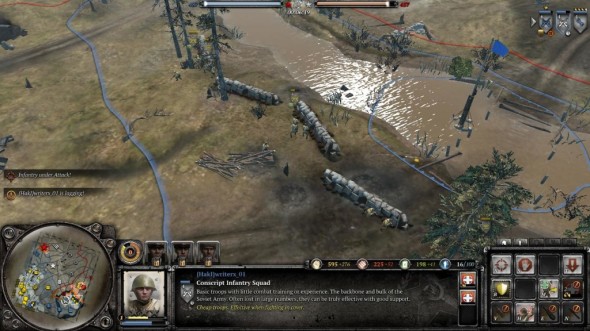
A Series of sandbag walls built by Soviet Conscripts. These will restrict enemy troop movement, but infantry can still climb over them, or move between the “cracks”.
Both sides have access to different types of Mines. It would be hard for me the generalize them, especially since each Commander can add more Mine types, but in general, you have Anti-Tank and Anti-Infantry Mines. Anti-Tank mines are typically VERY dangerous for light vehicles, such as half-tracks. Tanks will be damaged, but not destroyed as easily. Still, if you want to stop an assault very early on, Mines are the answer. Both the Germans and Soviets can combine their defensive structures, and thus using Bunkers/Sandbag walls for their infantry to hide in/behind, and then use mines up front to stop any foolish charge.
Unlike in the previous Company of Heroes game here you are unable to fortify, in any way, civilian structures. They can act as cover from enemy fire and the cold, but you CANNOT upgrade them into anything akin to the Barracks from Company of Heroes 1. Furthermore, based on my experience thus far, these building are extremely easy to take out with artillery fire, flamethrowers and even simple Molotovs. Any infantry inside will be “cooked”, leaving the building almost intact. However, too much fire can cause the structure, to literally, light up. This will result in a huge bonfire, turning the structure into rubble. It’s a pretty sight, but not too practical, especially on winter maps (unless you want to deny the enemy cover).
Bridges make an appearance again, but unlike in Company of Heroes 1 ordinary mortars are now capable of destroying them (that is, if we do count the small wooden bridges). Wooden bridges, just like in Company of Heroes 1, can be rebuilt using Combat Engineers and Pioneers. Be wary of Demolition Charges or enemy artillery that could take out your entire force with a single barrage. Not every single bridge can be destroyed, but bridges that can be destroyed will have a health bar you can observe while holding your mouse over them.
Combat in Company of Heroes 2 is intuitive. Let us begin with discussing the types of cover you will have access to. There is Red, Yellow and Green Cover.
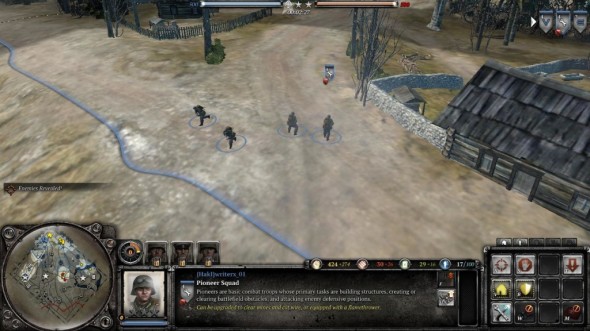
An Example of “Red Cover”. The Open and perfectly flat road does not benefit my infantry, they are very exposed.
Red Cover is “negative” cover, in the sense that infantry will be more exposed to enemy fire. This may be observed on open roads and bogs, where infantry will have nowhere to hide.
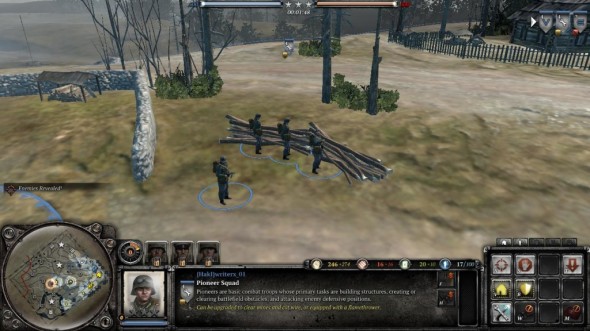
Most Wooden Structures offer Medium, or Yellow, Cover. Brushes, trees and shell craters will also provide yellow cover.
Yellow Cover is represented by, for example, wooden fences, brushes and barrels/crates. This type of cover is usually destructible, and in a lot of cases can also be run over by tanks or vehicles. Later on in the game you might observe that there is no Yellow Cover left. However, holes from artillery fire may be used as Yellow Cover.
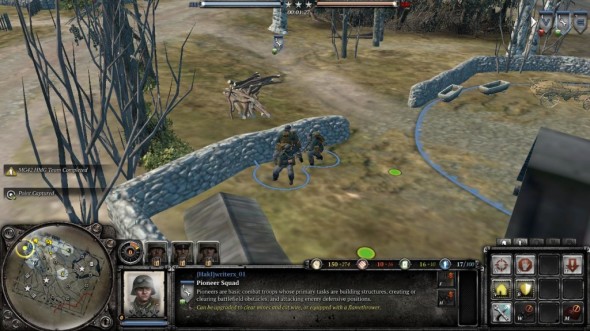
Most Stone or Metal Structures offer Green Cover, which is the best type of cover. Now your Infantry can feel almost safe.
Green Cover is the best type of cover. Tank wrecks, rocks and trenches are examples of green cover. The Soviet Sandbag wall also provides Green Cover. Green cover does not only provide the best protection for your infantry, but it will also be the most difficult to destroy, overall. You might find that Green Cover is impossible to take out, so you will have to outsmart the enemy in a number of ways.
Cover works in “directions”. Let us assume that a group of Soviet Soldiers is hiding behind a Sandbag Wall, and German Infantry is attacking them. The Soviets have green cover, as long as the enemy is separated from them by the wall. However, if the enemy flanks them, or attacks them from the rear, even the fact that your squad has a “Green Cover” icon does not mean they will benefit from it. As such, if you find enemy troops using Green Cover you can neglect that cover by moving around to their sides.
There is only one exception to cover, buildings. Structures (including bunkers) cannot be outflanked, in the traditional sense of the word. For example, if you had a flamethrower Engineer and you wanted him to take out an HMG nest inside a house you might want to use Conscripts to act as bait, forcing the HMG to fire at them, while the engineers move in from behind, away from the HMG fire, and light up the house. The bigger the building the more squads it can house. There is no “soldier” limit, so a small hut could act as a refuge for an HMG team (3 people) or a Conscript squad (6 soldiers). At the same time, while a house with three squads is very dangerous you could easily take out the huge threat with a single fire bomb, or KV-8, that would very rapidly burn out all of these squads.
Destroying buildings with Mortars or Tanks allows you to quickly destroy the structure, but it is not the best in killing the infantry within. Flamethrowers can kill a squad far quicker, while doing much less damage to the structure, allowing your own squads to use it.
One of the additions to Company of Heroes 2 is vaulting. In other words, you can order your Infantry to hop over low walls and obstacles. By holding your mouse over, let us say, a fence, and a yellow arrow appearing, pointing up, you can order a squad, or numerous squads, to hop over that fence section. This is especially useful when trying to surprise the enemy or when you want to reach a destination faster. Sometimes vaulting is simply the safest option, since a bunker could be blocking the main path, and then you have to sneak your way through.
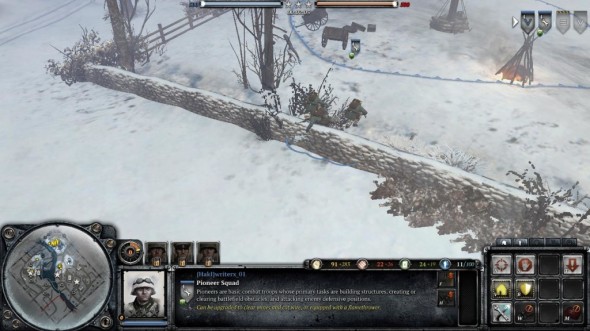
Pioneers climbing over a stone wall to more rapidly advance to the next point.
Vaulting can be done on most “low obstacles”, such as walls and fences. Large objects, like tanks and rocks, cannot be climbed over. Barbed Wire also cannot be climbed over. Sandbag walls can also be vaulted over, so you can use Panzer Grenadiers to climb over Soviet defenses to get an easier shot at the enemy.
Take note however, Infantry does not vault by default. If you do not order them to do so they will take the shortest “open” path, which sometimes mean turning a quick vault and walk into a lengthy sprint all around a fence.
In many ways I find Company of Heroes 2 to be a game about “hard counters”. For example, if the enemy is spamming infantry like mad a single KV-8 could take them all out. If the enemy relies on tanks you will use Anti-Tank Guns or Tank Destroyers. If the enemy calls in some type of special troops you analyze them and use what you think will be the best counter against them. For example, when faced with the a fore mentioned KV-8 you might be tempted to use Anti-Tank guns or Panzer Grenadiers. Unfortunately, the KV-8 is so efficient and tough that you would need overwhelming firepower to take it out before it kills your units. In this case you would prefer to use Stugs or P4s, because even though the KV-8 is powerful against Infantry it is much less impressive against tanks.
Some counters are more obvious than others. An Infantry Spam could be stopped by an HMG. Vehicle spams could be stopped with Anti Tank Guns. Artillery Spams could be stopped with fast moving vehicles or elite recon troops. Mortars are useful when taking out HMG but also Anti Tank Guns. You get the idea, if there is a problem there is also a solution.
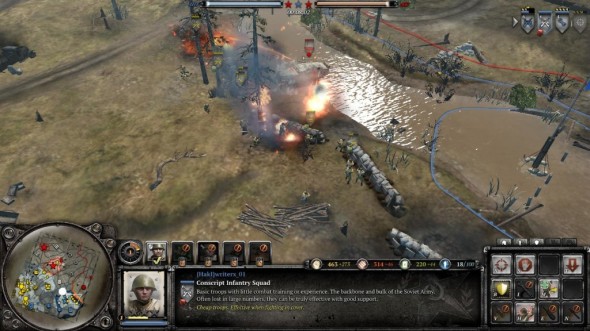
Remember that “Fortress” from earlier? It just got snuffed by a single Flame Halftrack, because we had no Anti-Tank Gun.
However, sometimes you have to take into account other elements in order to win an encounter, not just “hard counters”, these do not always work.
Another thing you must realise is the correlation between distance and weapon types. Most weapons perform far better if the enemy is closer. This does not only increase their accuracy but also their penetration. Some weapons are more restricted by range than others. SMG and Assault Rifles, for example, need to be closer than rifles, in order to be effective. So you might want to push up Panzer Grenadiers, or drive them into enemy positions with a half-track, allowing them to use their guns far more efficiently.
Tanks are very moody when it comes to penetration and flank. Every single Armored Vehicles and Tank will have the most armor on the front. So, for example, a T-70 will have no chance in penetrating a PIV or a Panther from the front. It might, however, achieve penetration by firing at the engine of any of these tanks. Distance and which side faces your guns influences penetration. Certain guns are far better than others. For example, I found the SU-76 to be an overall decent Tank Destroyer, but it will have a problem with Veteran PIVs and Panthers. The T-70 will have a hard time damaging any German tank. Even the T-34 might find it problematic to punch through a Panzer IV or a Panther, at times. In turn, the Panzer IV could have a problem penetrating the front of a SU-85, or that of the IS-2.
The key is flanking. Anti-Tank Guns and Panzerschrecks perform far better when fired at the flank of a tank than the front. Remember that.
Artillery, except for Mortars, can penetrate and damage tanks. Rocket Artillery is available to all Commanders, and even two such vehicles can turn the tide of any battle with a well placed barrage. However, they are expensive, so protect them well.
More information on the different Core units will be available in the soon-to-come Guide on the Germans and Soviets.
It will be hard for you not to face the Russian Winter, at some point during your games. All the Rivers will be frozen over. In some areas of the map Deep Snow will form. Some of your units will be able to construct Fires. Also, all your infantry units will be able to suffer from frostbite… and die.
Right, let’s start at the beginning. Usually during your initial game the map will be “flat”. No deep snow. There might be Fires spread all over the map, especially near locations you can capture. After your first Blizzard Deep Snow will form in some areas around the map.
Blizzards are periodical events during a battle on a Winter Map. Any Infantry Units out in the Blizzard will begin losing “heat”. Once their Heat is depleted there is a chance that slowly one by one your squad members will drop dead. Heat is replenished in a number of ways. The most basic one is constructing or walking up to a fire. Any side can use Fires, and they will always be “neutral”. You may choose to put a squad inside any civilian structure, this will warm them up and protect them from the blizzard. Half-tracks also keep your troops warm. I observed that, it would seem, some explosions and flame attacks can actually keep your troops (and the enemy) warm.
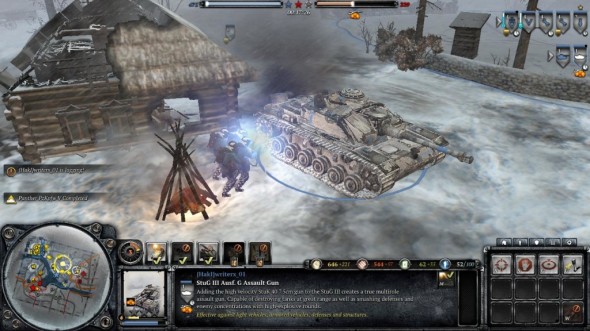
Blizzards can offer you a short respite from combat. In this case a squad of Pioneers were fixing up a Stug III, while staying warm next to a fire.
Vehicles are not as badly affected by the Blizzard. Their main problem will be shorter visibility, but since all sides suffer from that you could use the Blizzard to perform a sneak attack, and drop in Assault Troops up close and personal on the enemy front.
Furthermore, some abilities will not work during the Blizzard.
When recruiting new units, and you plan on sending them to the front, take into account distance. Make short “Fire Stops” to let your units regain some heat, otherwise they will freeze to death.
Deep Snow also causes a heat drop, even when there is no Blizzard. Furthermore, Deep Snow will slow down both Infantry and Vehicles. Artillery fire (and combat in general) can get rid of Deep Snow.
Frozen Rivers can be destroyed with artillery fire and other explosions. What this means is that any unit standing on top of a destroyed section of ice will sink to an icy death. Water will freeze over, after the ice was shattered, but this will always take some time.
Summer Maps are far more neutral to Winter Maps. There are no special weather conditions but shallow rivers (or bogs) can slow down both vehicles and tanks, making them crawl in them. On top of that any infantry in a “bog” will have negative cover, thus turning them into delicious targets for enemy units.
Other than that, enjoy the sun and warm weather… Until the winter comes…
These basics should let you pull through the absolute basics of the game. If you read this and are still interested in more I recommend checking up my Guide on the Germans and Soviets. This will also provide a lot of useful tips and hints, to perform better, or protect yourself, from one of the sides. If you are looking for more info we have a general list of Company of Heroes 2 Guides.

